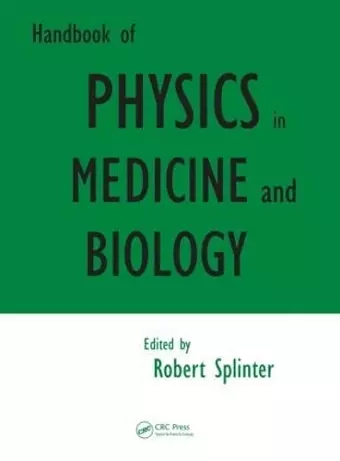Handbook of Physics in Medicine and Biology
Format:Hardback
Publisher:Taylor & Francis Inc
Published:5th Apr '10
Currently unavailable, and unfortunately no date known when it will be back
This hardback is available in another edition too:
- Paperback£63.99(9780367384319)

In considering ways that physics has helped advance biology and medicine, what typically comes to mind are the various tools used by researchers and clinicians. We think of the optics put to work in microscopes, endoscopes, and lasers; the advanced diagnostics permitted through magnetic, x-ray, and ultrasound imaging; and even the nanotools, that allow us to tinker with molecules. We build these instruments in accordance with the closest thing to absolute truths we know, the laws of physics, but seldom do we apply those same constants of physics to the study of our own carbon-based beings, such as fluidics applied to the flow of blood, or the laws of motion and energy applied to working muscle.
Instead of considering one aspect or the other,Handbook of Physics in Medicine and Biology explores the full gamut of physics’ relationship to biology and medicine in more than 40 chapters, written by experts from the lab to the clinic.
The book begins with a basic description of specific biological features and delves into the physics of explicit anatomical structures starting with the cell. Later chapters look at the body's senses, organs, and systems, continuing to explain biological functions in the language of physics.
The text then details various analytical modalities such as imaging and diagnostic methods. A final section turns to future perspectives related to tissue engineering, including the biophysics of prostheses and regenerative medicine.
The editor’s approach throughout is to address the major healthcare challenges, including tissue engineering and reproductive medicine, as well as development of artificial organs and prosthetic devices. The contents are organized by organ type and biological function, which is given a clear description in terms of electric, mechanical, thermodynamic, and hydrodynamic properties. In addition to the physical descriptions, each chapter discusses principles of related clini
The handbook includes hundreds of diagrams, images and tables, making it a useful tool for both medical physicists/engineers and other medical/biology specialists ... includes materials that are rarely combined together, which strengthens its interdisciplinary approach. -Physics in Medicine and Biology, 55 (2010) My deep impression is this is an excellent work by a highly competent team. The book chapters follow logically from the properties of the cell membrane through sensors and electroreception, biomechanics and fluid dynamics to the recording of bioelectrical signals, bioelectric impedence analysis, x-ray and computed tomography, magnetic resonance imaging, nuclear medicine, ultrasonic and thermographic imaging ... keep this book close at hand and do not hesitate to use it frequently. -BioMedical Engineering OnLine, 2010
ISBN: 9781420075243
Dimensions: unknown
Weight: 1519g
548 pages